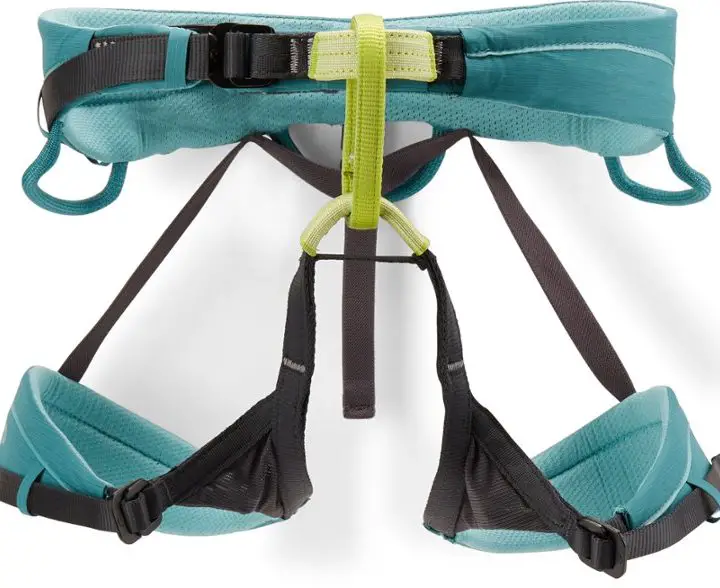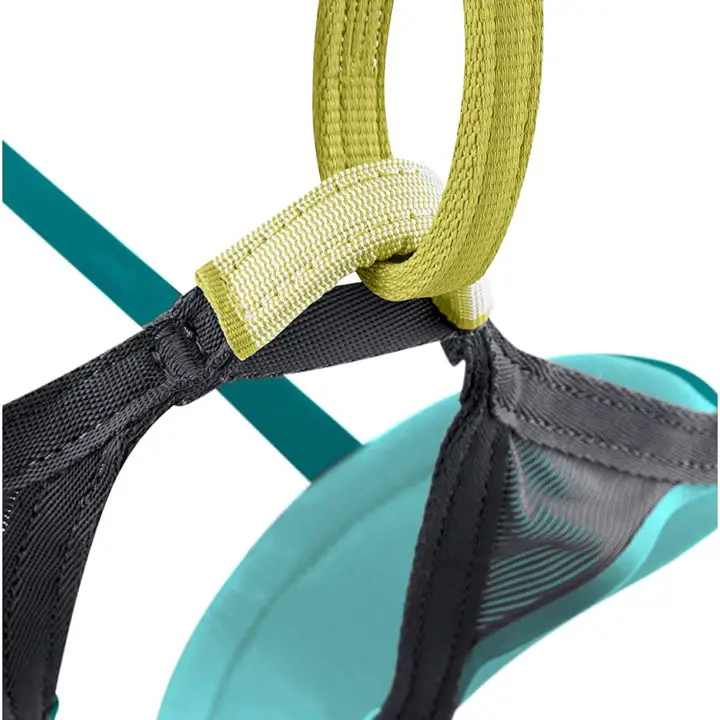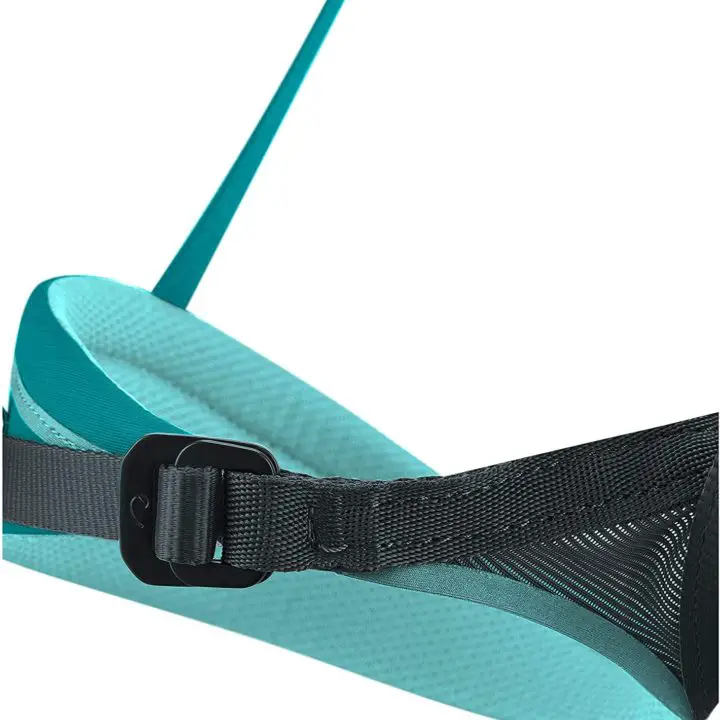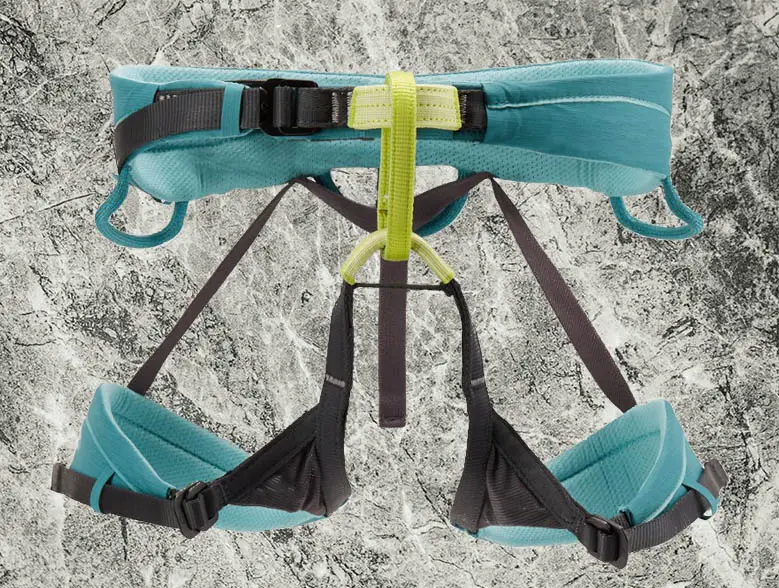A climbing harness is the main safety device that connects you to the rope and the belay device and is also what you will be wearing for hours at a time so it’s important to select the right harness for your adventures.
Because the harness is essential for your safety and comfort, you may wonder what harness is the best harness for climbing. That’s why I created this guide so you can see what harness I’d recommend and have the tools to make the best decision for yourself as well.
My Overall Recommendation: Edelrid Autana Harness

In case you want my recommendation without reading the rest of the article, here it is: I recommend the Edelrid Autana Harness
Here’s Why:
It has all the necessary features of a harness such as enough gear loops for bringing up your gear, adjustable leg loops, padded hips. It also has all of the premium features I need without a significant price increase:
- Metal buckles for the waist and legs
- Tie-in point with Dyneema wear indicator, which reveals internal red threads in case of increased abrasion
- Mesh padding for comfort
- Adjustable leg length so you can sit in it comfrotably when being lowered
- Detachable leg length for hiking and scrambling comfortably
- Light weight – you may not even notice you’re wearing it so it’s really comfortable
How long do harnesses last?
Something that I failed to consider when first getting a harness is how long your harness can last. After a quick search on Google, I assumed that I might be getting a new harness every season or two – this is not the case!
Climbing harnesses can last for years according to the manufacturers as long as you take care of it properly. This means that the harness you purchase today will be with you for years (assuming you take care of it properly).
So if you were like me and thinking that you’d just upgrade in a year or two, this is unlikely. Yes, you can purchase a new harness as often as you like but when you already have a harness, it’s likely that you’ll spend money on buying more quickdraws or new shoes instead.
Hanging Time and Comfort
One of the things that separate a climbers harness to those that you can rent at a climbing gym is the comfort while hanging on a route. When you’re at a climbing gym, you can get away with the uncomfortable rental harnesses because you’re only hanging in them for 5 minutes at a time. However, if you were to hang in the harness, you will find blood circulation getting cut off after only a few minutes of sitting on it.
The reason for this is because the webbing is constructed without padding and the shape of the harness is optimized for standing up – not sitting. Thus, the placement of it on your legs makes it super uncomfortable.
When you outdoor climb, you spend a lot more time hanging on the route. For example, you may get stuck on a part of the route and spend 10-15 minutes hanging on more difficult routes. With that in mind, you’re going to want a harness that supports you sitting and hanging.
The leg length is what enables you to adjust the seating position. If you are a shorter climber, then the length of your leg loops is significantly different to that of a tall climber. This makes adjustable leg lengths absolutely necessary – do not get a harness without this feature.
Key features you need for hangtime and comfort:
⭐ Padded leg loops
⭐ Adjustable leg loops
⭐ Adjustable leg lengths

Belaying Comfort
One of the key uses of a harness is to attach a belay device to the belayer. Unlike hangtime and comfort for sitting, you want to make sure that the harness is comfortable for standing as well as when you get pulled or jerked into the air as the belayer. The main features that help with this are the padded waist and leg loops.
In addition to padding for comfort, you want a belay loop that is vertical so it works with any type of belay device. Really you can make any belay loop work but the vertical belay loops (found in 90% of harnesses), work with carabiners a lot better.
Key features you need for belaying comfortably
⭐ Padded leg loops
⭐ Padded waistband
⭐ Vertical belay loop
Walking Comfort and Mobility
Similar to belaying comfort, you want to make sure that the harness is comfortable to stand in. Additionally, if you are moving to a different crag, you’ll want a harness that is comfortable to walk, hike and scramble in. Some harnesses have very uncomfortable leg loops when it comes to hiking and scrambling, simply because the leg loops aren’t adjustable and made to put you in a sitting position.
To ensure that the harness you purchase will be comfortable to hike from route to route, just make sure that the leg length loops are adjustable, or even better, detachable. Many of the mid-grade harnesses have detachable leg length loops and almost all of the high-grade harnesses have this feature.
Key features you need for mobility
⭐ Adjustable leg loops
⭐ Adjustable leg lengths
⭐ Detachable leg length loops

Extra Features and Assesories
Gear Loops are the most necessary accessory for outdoor climbing as they will be what you use to carry the quickdraws, personal anchor, and anything else up the route with you. Most Mid-range to High-end harnesses have 4-5 gear loops. The Edelrid Autana has 5 gear loops and 2 ice climbing gear loops (in case you need versatility).
Metal adjustment leg loops are also in the boat of things that I’d consider necessary. A mistake that I made with my current harness was thinking that the adjustable buckles don’t matter as much because tightening loops are only for comfort. With that thought in mind, I got a harness with plastic adjustable leg loops. Unfortunately, 2 seasons in, one of the leg loops broke. Since I don’t ever tighten the leg loops, it doesn’t bother me often. However, sometimes the broken plastic digs into my leg, which isn’t fun at all. The Edelrid Autana overcomes that concern with metal loops.
Abrasion Indicators are ways that the manufacture creates the harness so you have a better idea of when you need to retire the harness. There aren’t many harnesses that have this feature but it is so nice to have for peace of mind. Plus, if something happens between climbs, you know exactly when you need to replace the harness. The Edelrid Autana has Dyneema wear indicator, which reveals internal red threads in case of increased abrasion.
Versatility
When it comes to harnesses, typically you’ll use if for climbing, and where versatility comes in is what type of climbing you’re going to be doing such as ice climbing or projecting on a difficult route outdoors.
If you only climb at the gym, then you won’t need gear loops or a place to hook on your ice pick. You may not even need padding for your legs and hips if you don’t plan on hanging very long.
However, if you are outdoors projecting a difficult route, then you’re going to need a harness that is comfortable to sit/hang in. Additionally, you’ll want enough gear loops to hold all of your gear as you go up the route.
For me, I also like rappelling and canyoneering so I need a harness that is comfortable to sit in, walk, hike, scramble, etc. Being lightweight is also a huge plus – maybe I’ll even forget that I’m wearing it. The Edelrid Autana meets all of those requirements.
► Best Harness for Rappeling
More About Climbing:
- My Favorite Harness For Climbing
- Belaying 101: You Shouldn’t Climb Without Reading This
- How To Belay With A Grigi For Top Rope Climbing | With Photos And Video
- How Climbing Routes Are Set: Interview With Team Usa Chief Route Setter Mike Bockino
- How To Put On A Harness
- What You Need To Know Before Starting Indoor Rock Climbing
- How To Belay: Using Assisted Locking Belay Devices
- How Should Your Climbing Harness Fit?
- How Are Climbing Routes Graded?
- What You Should Wear While Climbing
- What Affects How Climbing Shoes Fit?
- 7 Common Mistakes In Rock Climbing For Beginners
- Why Is Climbing Such A Mental Sport?
More Buyer’s Guides:
- The Top 5 Crash Pads For Bouldering: How To Decide Which Is Best
- Diy Hangboard With Jugs And Edges For Less Than $15
- 6 Of The Best Belay Devices For Beginner Climbers
- The Best 11 Climbing Shoes Under $100
- Climbing Chalk: Chunky Vs. Fine
- The Best Chalk For Climbing And Bouldering
- Rock Climbing Starter Kits For Beginners Compared
- Liquid Chalk Vs. Dry Chalk For Bouldering (Hint: Dry Chalk Is Better)
- Top 5 Gear You Need In Your Climbing Pack For The Best Experience
- What To Wear While Bouldering
- Should You Upgrade To An Assisted-Braking Belay Device?
- Everything You Need To Know About Climbing Chalk
- 37 Things Serious Climbers Bring With Them To The Mountains
- Clothing For Climbing In The Gym – What Should You Wear?
- Can You Climb Without Chalk?
- How Tight Climbing Shoes Should Fit For The Best Performance
- Harnesses For Rappeling
- My Favorite Harness For Climbing
- What You Should Wear While Climbing
- What Affects How Climbing Shoes Fit?
- How To Clean Your Grigri
- How To Care For Your Climbing Rope


